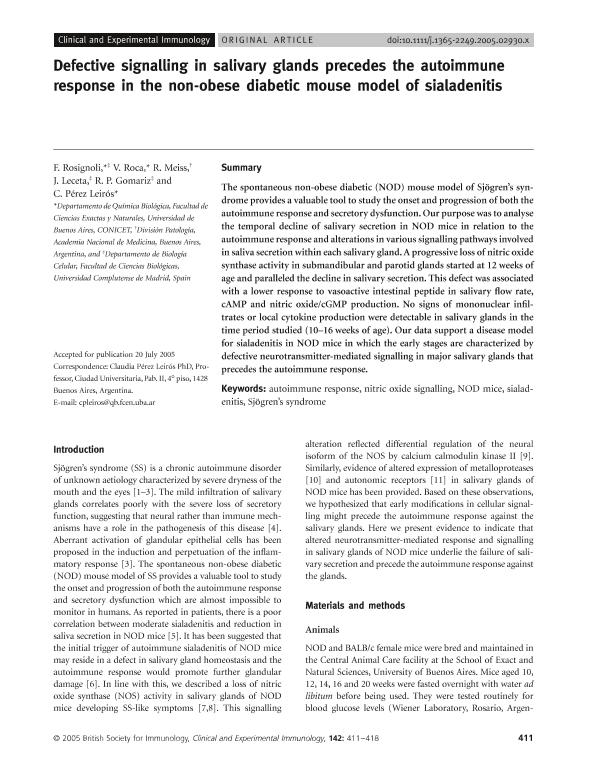Artículo
Defective signalling in salivary glands precedes the autoimmune response in the non-obese diabetic mouse model of sialadenitis
Rosignoli, F.; Roca, Valeria Ines ; Meiss, R.; Leceta, J.; Gomariz, Roberto Luis; Perez Leiros, Claudia
; Meiss, R.; Leceta, J.; Gomariz, Roberto Luis; Perez Leiros, Claudia
 ; Meiss, R.; Leceta, J.; Gomariz, Roberto Luis; Perez Leiros, Claudia
; Meiss, R.; Leceta, J.; Gomariz, Roberto Luis; Perez Leiros, Claudia
Fecha de publicación:
12/2005
Editorial:
Wiley Blackwell Publishing, Inc
Revista:
Clinical and Experimental Immunology
ISSN:
0009-9104
e-ISSN:
1365-2249
Idioma:
Inglés
Tipo de recurso:
Artículo publicado
Clasificación temática:
Resumen
The spontaneous non-obese diabetic (NOD) mouse model of Sjögren's syndrome provides a valuable tool to study the onset and progression of both the autoimmune response and secretory dysfunction. Our purpose was to analyse the temporal decline of salivary secretion in NOD mice in relation to the autoimmune response and alterations in various signalling pathways involved in saliva secretion within each salivary gland. A progressive loss of nitric oxide synthase activity in submandibular and parotid glands started at 12 weeks of age and paralleled the decline in salivary secretion. This defect was associated with a lower response to vasoactive intestinal peptide in salivary flow rate, cAMP and nitric oxide/cGMP production. No signs of mononuclear infiltrates or local cytokine production were detectable in salivary glands in the time period studied (10-16 weeks of age). Our data support a disease model for sialadenitis in NOD mice in which the early stages are characterized by defective neurotransmitter-mediated signalling in major salivary glands that precedes the autoimmune response.
Archivos asociados
Licencia
Identificadores
Colecciones
Articulos(IIBBA)
Articulos de INST.DE INVEST.BIOQUIMICAS DE BS.AS(I)
Articulos de INST.DE INVEST.BIOQUIMICAS DE BS.AS(I)
Articulos(IQUIBICEN)
Articulos de INSTITUTO DE QUIMICA BIOLOGICA DE LA FACULTAD DE CS. EXACTAS Y NATURALES
Articulos de INSTITUTO DE QUIMICA BIOLOGICA DE LA FACULTAD DE CS. EXACTAS Y NATURALES
Citación
Rosignoli, F.; Roca, Valeria Ines; Meiss, R.; Leceta, J.; Gomariz, Roberto Luis; et al.; Defective signalling in salivary glands precedes the autoimmune response in the non-obese diabetic mouse model of sialadenitis; Wiley Blackwell Publishing, Inc; Clinical and Experimental Immunology; 142; 3; 12-2005; 411-418
Compartir
Altmétricas



